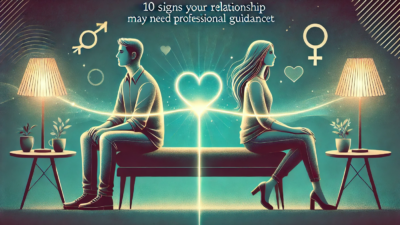Have you ever felt that no matter how hard you try, your conversations with your partner just seem to end in frustration? Miscommunication is one of the leading causes of conflict in relationships, and yet it’s something many couples struggle with daily. Research indicates that effective dialogue not only resolves conflicts but also deepens connection and trust. In this article, we’ll explore expert tips on overcoming communication breakdowns and transforming misunderstandings into opportunities for growth. If you’re ready to improve your relationship through better communication, read on for practical advice rooted in psychological theory and real-world practice.
Understanding Communication Breakdowns
Communication breakdowns occur when messages are not conveyed or received as intended, leading to misunderstandings, frustration, and conflict. To effectively overcome these breakdowns, it’s crucial to understand their roots and how they manifest in relationships.
What Causes Communication Breakdowns?
Several factors contribute to communication issues in relationships:
- Assumptions: Unspoken expectations or beliefs can lead to misunderstandings.
- Defensive Responses: Reacting with defense rather than openness blocks honest conversation.
- Emotional Triggers: Past hurts and insecurities may cause disproportionate responses.
- Lack of Active Listening: Not truly hearing your partner can result in misinterpretation.
The Importance of Effective Communication
Healthy communication is the cornerstone of a strong relationship. It allows partners to express needs, validate emotions, and build empathy, leading to deeper connection and trust. According to psychological theories on language and perception, much of our misunderstanding arises from unspoken assumptions and a lack of emotional attunement. By learning to navigate these common pitfalls, couples can transform conflicts into chances for growth.
Common Barriers in Relationship Communication
Understanding specific barriers can help couples address them head-on. Here are some frequent obstacles:
Assumptions and Misinterpretations
Assumptions often fill gaps in communication, leading to false interpretations of a partner’s words or actions.
- Impact: Assumptions create a foundation of misunderstanding and resentment.
- Solution: Always seek clarity by asking questions rather than making assumptions.
Defensive Responses
When feeling attacked, partners may become defensive, hindering open dialogue.
- Impact: Defensive behavior escalates conflicts and prevents resolution.
- Solution: Practice vulnerability by lowering defenses and inviting honest feedback.
Emotional Triggers
Emotional triggers from past experiences can color current conversations.
- Impact: Triggers can lead to overreactions or shutting down communication.
- Solution: Identify your triggers and discuss them openly with your partner, creating empathy and understanding.
Relationship Expert Tips to Overcome Misunderstandings
Overcoming communication breakdowns requires intentional strategies. Below are expert tips to navigate and repair misunderstandings effectively.
Tip 1: Practice Active Listening
Active listening involves fully concentrating, understanding, responding, and then remembering what is being said.
How to Do It:
- Give Full Attention: Put aside distractions like phones or TV.
- Reflect: Paraphrase what your partner said to confirm understanding.
- Respond Thoughtfully: Answer based on what you heard, not what you assumed.
- Avoid interrupting while your partner speaks.
- Maintain eye contact and open body language.
- Use phrases like “What I hear you saying is…” to show engagement.
Tip 2: Use Reflective Feedback
Reflective feedback is about summarizing what you’ve heard and validating your partner’s feelings.
Benefits:
- It ensures that both parties feel heard and understood, reducing frustration.
How to Use It:
- After your partner speaks, summarize their main points.
- Validate their emotions by acknowledging how they feel.
Tip 3: Practice Nonviolent Communication (NVC)
Nonviolent Communication is a method that encourages expressing feelings and needs without blame.
NVC Steps:
- Observation: State facts without judgment.
- Feelings: Express how you feel about the situation.
- Needs: Communicate your needs clearly.
- Request: Make a request for action that might meet those needs.
Example:
Instead of saying, “You never listen to me,” try, “When I share my feelings and feel unheard, I feel frustrated. I need more attentive listening. Would you be willing to put down your phone and focus on our conversation?”
Solutions and Actionable Tips for Better Communication
Building on expert tips, here are practical steps you can implement to overcome communication breakdowns in your relationship.
Creating a Safe Environment
- Choose the Right Moment: Find a calm time to discuss sensitive issues.
- Set Ground Rules: Agree on respectful dialogue norms (e.g., no interrupting, no name-calling).
- Emphasize Empathy: Approach conversations with a mindset to understand, not to win.
Techniques for Clear Communication
- Use “I” Statements: Clearly express how you feel without blaming. Example: “I feel upset when plans change last minute because it makes me feel unimportant.”
- Validate Emotions: Acknowledge your partner’s feelings, even if you disagree. Example: “I understand that you’re feeling hurt, and I’m sorry for contributing to that.”
- Practice Patience and Calmness: Take deep breaths if you feel overwhelmed. Pause the conversation if needed and resume once both parties are calm.
- Maintain a calm tone of voice.
- Avoid accusatory language.
- Focus on resolving the issue rather than winning the argument.
Building Empathy
Practicing Empathy is critical in bridging communication gaps. It involves understanding your partner’s perspective without immediate judgment.
Steps to Build Empathy:
- Ask open-ended questions: “How did that make you feel?”
- Share personal experiences to relate to their emotions.
- Express compassion and support.
Understanding Psychological Theories on Communication
Grounding these communication strategies in psychological theories can enhance understanding and application.
Language and Perception in Relationships
Psychological theories suggest that language shapes perception. Misunderstandings often arise when partners project their own fears and biases onto words.
Theory in Practice:
- Recognize that your interpretation of a partner’s words might be influenced by past experiences.
- Solution: Seek clarification rather than assuming negative intent.
The Role of Emotional Attunement
Emotional attunement refers to the ability to accurately read and respond to your partner’s emotional cues. When attuned, partners feel understood and valued.
Case Studies: Communication Transformations
Real-life scenarios illustrate how couples have successfully overcome communication breakdowns.
Case Study 1: Breaking the Cycle of Misunderstanding
A couple constantly clashed over minor issues until they learned active listening and nonviolent communication techniques. By implementing reflective feedback and empathic listening, they transformed their conflicts into productive discussions, fostering deeper connection and trust.
Case Study 2: Healing Through Empathy
Another couple faced repeated misunderstandings stemming from unspoken assumptions. After seeking professional guidance, they learned to validate each other’s emotions and set healthy communication boundaries. This shift led to a more compassionate dialogue and reduced conflict.
Challenges and Solutions in Building Better Communication
Even with strategies in place, challenges persist. Here are common hurdles and how to address them.
Challenges
- Resistance to Change: One or both partners may be hesitant to adopt new communication styles.
- Emotional Overwhelm: Intense emotions can derail even the best-laid plans for healthy dialogue.
- Persistent Misunderstandings: Some issues may repeatedly cause confusion despite efforts.
Solutions
- Gradual Implementation: Introduce new techniques slowly, allowing time for adjustment.
- Seek Professional Help: A therapist can guide couples through persistent communication challenges.
- Practice Regularly: Consistency builds new habits and reinforces skills over time.
The Role of a Clinical Psychologist in Improving Communication
A clinical psychologist can offer tailored approaches to help couples navigate and improve their communication.
How Therapy Supports Communication
- Assessment: Identifying specific communication patterns and breakdowns.
- Customized Strategies: Offering techniques like active listening exercises, role-playing scenarios, and empathy-building activities.
- Safe Space: Providing a confidential environment where both partners can practice new skills without fear of judgment.
Conclusion
Overcoming communication breakdowns is essential for a healthy, thriving relationship. By understanding the common barriers, applying expert tips like active listening, reflective feedback, and nonviolent communication, and grounding strategies in psychological theory, couples can transform misunderstandings into opportunities for deeper connection. Remember that improving communication is an ongoing process that requires patience, empathy, and practice.
Call-to-Action:
Feeling overwhelmed? Don’t wait until the signs escalate. Book your therapy session with me now! A compassionate, experienced clinical psychologist can provide the guidance and support you need to overcome these challenges and build a stronger relationship.
Follow this link to join WhatsApp channel for more insights: Join Now.




[…] of open, honest communication can create emotional barriers. When partners have a communication breakdown, they stop sharing their feelings, misunderstandings grow, distancing them […]
[…] shows that developing EQ—through self-awareness, empathy, and self-regulation—can significantly enhance communication and conflict resolution in marriages. In this blog, we’ll explore the role of emotional intelligence in successful couples therapy, […]
[…] for myself. It led to a breakdown, followed by depression and even medication. It even lead to fights in my relationship where I was not able to handle my self, emotions and expectations causing extreme burden on my […]
[…] couple struggling with jealousy found that open communication and setting boundaries alleviated their fears. The jealous partner began journaling to identify triggers while the other […]
[…] It Matters: Open and honest communication helps couples express their needs, understand each other’s perspectives, and resolve conflicts […]
[…] Communication gaps and misunderstandings that pile up over time. […]
[…] Effective communication is at the heart of every strong relationship. Mindfulness in communication involves: […]